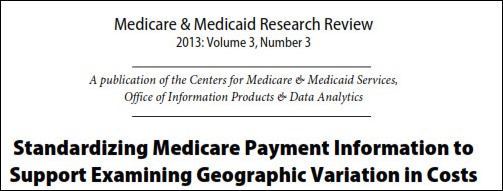Hard agree, and not just because I'm a spreadsheet nerd. Why are we all here? Isn't it in the service…
Readers Write: Provider Charges: An Excellent Start
Provider Charges: An Excellent Start
By Data Nerd

Any data nerd worth his or her salt will tell you that a thorough analysis starts with vetting, mining, scrubbing, and purging compilations of data. Most of my time on any analysis project is spent understanding the context and cleansing data to the point that I can work with it confidently. So, when I came across this Medicare and Medicaid Research Review article, I wanted to bring it to the HIStalk readership’s attention as an excellent methodology for doing meaningful cost analysis across the country.
Remember earlier this summer when CMS unleashed the tip of the kraken with average DRG charges for hospitals? I say the tip of the kraken because (1) it was really a minute slice of a much larger pie, and (2) the data was sliced, diced, and visualized to a bloody pulp and although we haven’t seen a new release of data to confirm, we certainly aren’t hearing about any major price shifts in the market. As a similar release for individual providers is being considered, here is something meaningful we can do to actually understand and do something about real price variation.
Adjusting for acuity and policy factors that influence prices is essential to understanding why one provider charges more than another. Just like it was insufficient for CMS to release DRG data with average charges when patients could be treated for up to 25 diagnoses and 25 procedures in the same charge amount, it will be meaningless to release individual provider charges without the context of treatment.
Usually, I’m the first to ask for atomic “Collect Once Use Many Times” data elements (hard numbers on which to base other calculations), but in this case, relative weights really are more meaningful if you want to scout out the root of price differences. Are abnormally high salaries driving price? Supply chain inconsistencies? Medical errors? If you really want to know why one provider charges more than another, you need to hold all things constant, and the methodology outlined in this paper is an excellent start.
What do you think? Is it more meaningful to look at hard numbers (Hospital A charges $x vs Hospital B charges $y) or a relative weight holding wage and policy initiatives constant? Do relative weights obstruct meaning or provide a lens through which we can view data more clearly?


Some indications that prices have increased:
http://www.modernhealthcare.com/article/20130917/NEWS/309179963#
“For the year that ended in August 2013, prices increased 5.7%, compared with 4.7% the prior year.”
http://www.healthcarefinancenews.com/news/healthcare-prices-flat-through-august
While Bureau of Labor Statistic’s Producer Price Index fell for hospitals 0.1% from July to August, Hospital prices were 1.6% higher than they were a year ago.